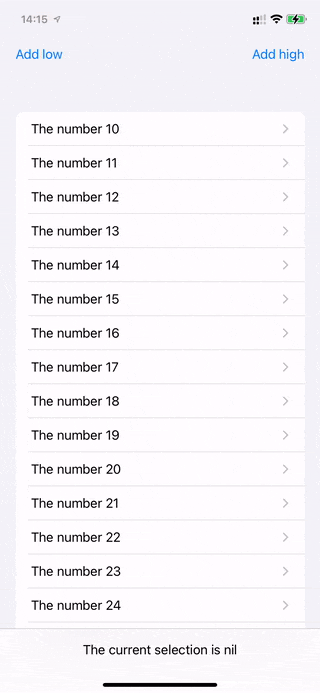我有一个 Form 中的项目列表在 NavigationView , 每个都有一个可以通过 NavigationLink 访问的详细 View .
当我向列表中添加一个新元素时,我想显示它的详细 View 。为此,我使用 @State var currentSelection该NavigationLink接收为 selection ,并且每个元素的功能为 tag :
NavigationLink(
destination: DetailView(entry: entry),
tag: entry,
selection: $currentSelection,
label: { Text("The number \(entry)") })
令人惊讶的是,它 站当列表的元素多于屏幕(加上〜2)时工作。问:为什么?我该如何解决它?
我做了一个最小的例子来复制行为:
import SwiftUI
struct ContentView: View {
@State var entries = [10, 11, 12, 13, 14, 15, 16, 17, 18, 19, 20, 21, 22, 23, 24, 25]
@State var currentSelection: Int? = nil
var body: some View {
NavigationView {
Form {
ForEach(entries.sorted(), id: \.self) { entry in
NavigationLink(
destination: DetailView(entry: entry),
tag: entry,
selection: $currentSelection,
label: { Text("The number \(entry)") })
}
}
.toolbar {
ToolbarItem(placement: ToolbarItemPlacement.navigationBarLeading) { Button("Add low") {
let newEntry = (entries.min() ?? 1) - 1
entries.insert(newEntry, at: 1)
currentSelection = newEntry
} }
ToolbarItem(placement: ToolbarItemPlacement.navigationBarTrailing) { Button("Add high") {
let newEntry = (entries.max() ?? 50) + 1
entries.append(newEntry)
currentSelection = newEntry
} }
ToolbarItem(placement: ToolbarItemPlacement.bottomBar) {
Text("The current selection is \(String(describing: currentSelection))")
}
}
}
}
}
struct DetailView: View {
let entry: Int
var body: some View {
Text("It's a \(entry)!")
}
}
label: { Text("The number \(entry).padding(30)") }))正如您在屏幕记录中看到的那样,在达到临界数量的元素后(通过预先或附加到列表),底部工作表仍然显示
currentSelection正在更新,但没有导航发生。我使用了 iOS 14.7.1、Xcode 12.5.1 和 Swift 5。


最佳答案
发生这种情况是因为没有渲染较低的项目,所以在层次结构中没有 NavigationLink有这样的标签
我建议您使用 ZStack + EmptyView NavigationLink “黑客”。
我也在这里使用 LazyView,感谢 @autoclosure它让我通过包装 currentSelection : 这只会在 NavigationLink 时调用处于事件状态,这发生在 currentSelection != nil
struct ContentView: View {
@State var entries = [10, 11, 12, 13, 14, 15, 16, 17, 18, 19, 20, 21, 22, 23, 24, 25]
@State var currentSelection: Int? = nil
var body: some View {
NavigationView {
ZStack {
EmptyNavigationLink(
destination: { DetailView(entry: $0) },
selection: $currentSelection
)
Form {
ForEach(entries.sorted(), id: \.self) { entry in
NavigationLink(
destination: DetailView(entry: entry),
label: { Text("The number \(entry)") })
}
}
.toolbar {
ToolbarItem(placement: ToolbarItemPlacement.navigationBarLeading) { Button("Add low") {
let newEntry = (entries.min() ?? 1) - 1
entries.insert(newEntry, at: 1)
currentSelection = newEntry
} }
ToolbarItem(placement: ToolbarItemPlacement.navigationBarTrailing) { Button("Add high") {
let newEntry = (entries.max() ?? 50) + 1
entries.append(newEntry)
currentSelection = newEntry
} }
ToolbarItem(placement: ToolbarItemPlacement.bottomBar) {
Text("The current selection is \(String(describing: currentSelection))")
}
}
}
}
}
}
struct DetailView: View {
let entry: Int
var body: some View {
Text("It's a \(entry)!")
}
}
public struct LazyView<Content: View>: View {
private let build: () -> Content
public init(_ build: @autoclosure @escaping () -> Content) {
self.build = build
}
public var body: Content {
build()
}
}
struct EmptyNavigationLink<Destination: View>: View {
let lazyDestination: LazyView<Destination>
let isActive: Binding<Bool>
init<T>(
@ViewBuilder destination: @escaping (T) -> Destination,
selection: Binding<T?>
) {
lazyDestination = LazyView(destination(selection.wrappedValue!))
isActive = .init(
get: { selection.wrappedValue != nil },
set: { isActive in
if !isActive {
selection.wrappedValue = nil
}
}
)
}
var body: some View {
NavigationLink(
destination: lazyDestination,
isActive: isActive,
label: { EmptyView() }
)
}
}
NavigationLink 有帮助:在真正的应用程序中,目的地可能是一个巨大的屏幕,当你有一个 NavigationLink在每个单元格中,SwiftUI 将处理所有可能导致滞后的单元格
关于ios - 如果未显示所有 NavigationLink,则 NavigationView 中 SwiftUI 的 NavigationLink `tag` 和 `selection` 将停止工作,我们在Stack Overflow上找到一个类似的问题: https://stackoverflow.com/questions/68783396/